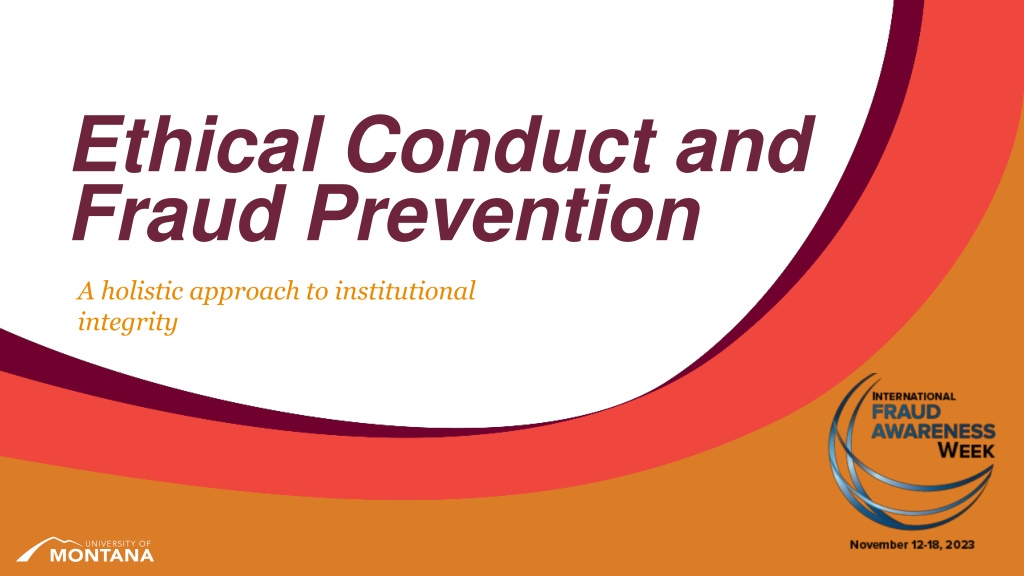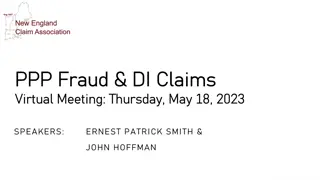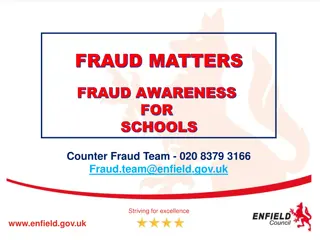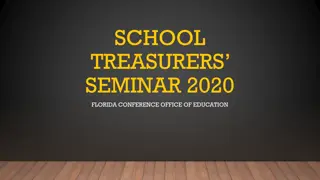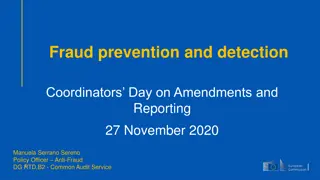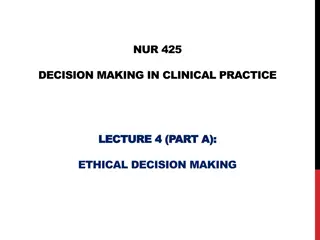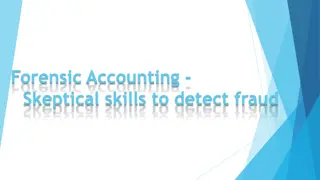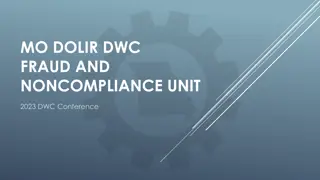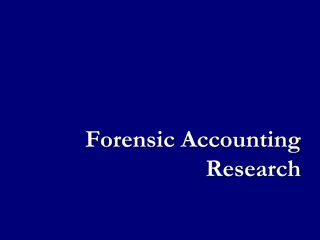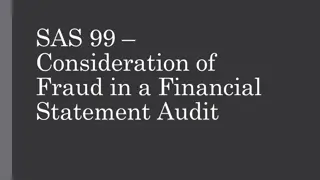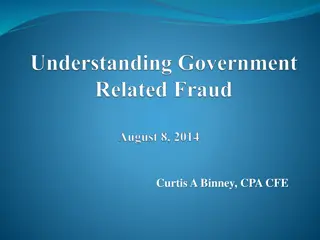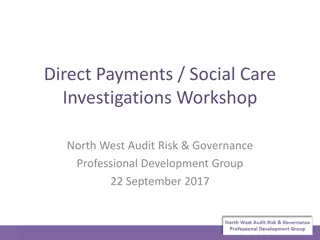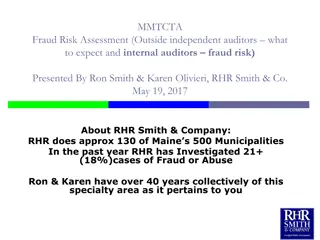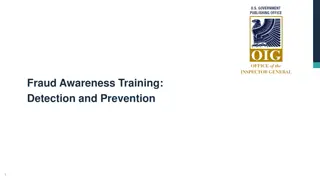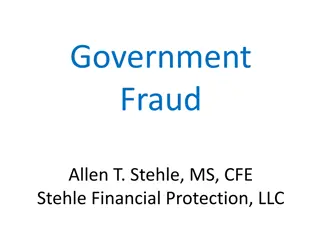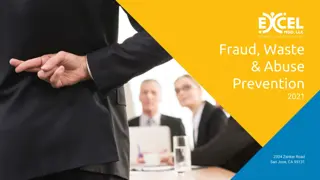Understanding Ethical Conduct and Fraud Prevention in Institutions
Explore the nuances between ethics and fraud, famous fraud cases like Enron and Bernard L. Madoff Investment Securities LLC, and learn how to detect and prevent fraudulent activities within institutions. Recognize the importance of ethical behavior, early detection, and fraud prevention measures to uphold institutional integrity.
Download Presentation

Please find below an Image/Link to download the presentation.
The content on the website is provided AS IS for your information and personal use only. It may not be sold, licensed, or shared on other websites without obtaining consent from the author. Download presentation by click this link. If you encounter any issues during the download, it is possible that the publisher has removed the file from their server.
E N D
Presentation Transcript
Ethical Conduct and Fraud Prevention A holistic approach to institutional integrity
Agenda 1. Ethics vs Fraud 2. Famous Fraud Cases 3. Higher Ed Fraud 4. Blind Spots 5. Understanding Fraud 6. Your Role as an Employee
Learning Objectives At the end of this session, you should be able to: 1. Differentiate between unethical behavior and fraudulent activities; 2. Understand the importance of early detection of ethical issues; 3. Recognize red flags or warning signs of potential fraudulent activities; 4. Identify fraud prevention measures and controls.
Poll Is fraud happening at the University of Montana? Absolutely - I ve witnessed and/or reported it. It s likely but I haven t witnessed it. Probably, but not in my department because we have adequate controls in place to prevent it. No, we re in Montana where everyone is honest.
Ethics vs Fraud Ethics: Moral principles and values that guide individuals or organizations in making decisions. Focuses on what is morally right or wrong, just, and fair, rather than the legality of an action. Ethics Fraud: intentional deception or misrepresentation for financial gain or other advantages. Fraud
Famous Cases Cooking the books and hiding financial troubles in the long term will not benefit anyone in the company. It only benefits a very small group for a very short time. -Andrew Fastow
Enron What happened: Highly complex, multi-year accounting fraud. Debt concealment The Result: $74 billion loss in market capitalization. Arthur Andersen bankruptcy. 29 000 employees impacted.
Bernard L. Madoff Investment Securities LLC What Happened: Ponzi scheme. Victims included hedge funds, pension plans, and university endowments. The Result: $64.8 billion in losses. Deaths by suicide. Reputational damage - SEC JP Morgan, and other institutions.
Almeida Research & FTX Trading Ltd. What Happened: Highly speculative crypto trades. Unauthorized transfers of clients cryptocurrency deposits. The Result: $8 billion shortfall in customer assets.
Fraud in Higher Education The fraudster greatest liability is the certainty that the fraud is too clever to be detected -Lewis J. Freeh
Operation Varsity Blues Consultant received a total of $25 million to fabricate fake credentials and inflate ACT/SAT test scores. 50 people charged with participating in a scheme to cheat the college admissions system at select colleges.
Academic Fraud to Keep Athletes Playing 3,100 students took paper classes and obtained artificially high grades to meet eligibility requirements. Individuals involved included football coaches, department chairs, academic advisors, and deans.
Experts on Dishonesty Accused of Fraud Francesca Gino - Harvard University Studies featured in The Economist, The New York Times, Newsweek, The Wall Street Journal. Dan Ariely - Duke University Lg Nobel Prize winner. Author of several books about irrationality, dishonesty, and decision making.
Blind Spots It s not always - or nor only - the initial mistake that brings down a leader. It s the response or lack thereof. -Chronicle of Higher Education
Blind Spot #1 - Motivated Blindness The tendency of people to overlook the unethical behavior of others when it is not in their best interest to notice their infraction Bazerman and Tenbrunsel Blind Spots - 2011
Blind Spot #2 The Slippery Slope Initial Slip Faculty develops a close mentoring relationship with a student Boundary Erosion Favoritism, unwarranted academic benefits Conflicts of Interest Inappropraite personal relationship Ethical Violations Breaches of professional conduct Consequences Disciplinary actions, reputational risk
Blind Spot #3 - Unconscious Biases Anchor Unconscious biases are learned assumptions, beliefs, or attitudes that we aren t necessarily aware of. -Asana Authority Conformity
Ethical Dilemma Imagine that you are standing on a footbridge spanning some trolley tracks. You see that a runaway trolley is threatening to kill five people. Standing next to you, in between the oncoming trolley and the five people, is a person wearing a large backpack. You quickly realize that the only way to save the people is to push the man off the bridge and onto the tracks below. The man will die, but his body will stop the trolley from reaching the others. (You quickly understand that you can t jump yourself because you aren t carrying enough weight to stop the trolley, and there s no time to put on the man s backpack.) Legal concerns aside, would it be ethical for you to save the five people by pushing this stranger to his death?
Additional Facts Now, imagine that you find out the five people on the trolley tracks are your family members. Does this additional information change your ethical stance on pushing the stranger off the bridge to save them?
Lets Introduce Another Element to the Scenario You learn that the stranger wearing the backpack is a world-renowned scientist on the verge of making a groundbreaking discovery that could save countless lives. Does this new information impact your ethical judgment about pushing the stranger to save the five people?
Continuing with the Scenario You discover that the five people on the trolley tracks are all convicted criminals who have committed serious, violent crimes. Does this knowledge influence your ethical perspective regarding pushing the stranger to save them? How so?
In This Final Twist You realize that there's an emergency lever nearby that can divert the trolley onto a different track, saving both the stranger and the five people. Knowing this, does it change your initial ethical judgment? What factors might affect your decision now?
Understanding Fraud In a way, fraud in business is no different from infidelity in marriage or plagiarism in scholarly work. Even people committed to high moral standards succumb. -Miroslav Volf
Fraud Triangle Greed Addictions Poor credit/cash management Dissatisfaction with pay Overlooked for a promotion I ll pay it back. I deserve a pay raise. It s for a good purpose. Weak internal controls Ineffective monitoring of controls Assets susceptible to fraud Flaw in the system
Red Flag Behaviors 8 most common behavioral clues of occupational fraud Living beyond their means Financial difficulties Unusually close association with vendor or customer Control issues-unwillingness to share duties Irritability, suspiciousness, or defensiveness Bullying or intimidation Divorce or family problems Wheeler-dealer attitude
The key to successful fraud prevention is making everyone in the company accountable for detecting and reporting illegal or suspicious behavior and that s only possible when the ethics policy is clearly communicated and employees understand what the organization considers to be acceptable and unacceptable behavior. Roy Cupler & Gina St. George Ethical Behavior in the Midst of Fraud 2015
Fraudulent Behaviors Misuse of Resources Misrepresentation Time Theft Conflict of Interest Bullying or Harassment Neglect of Duty Sabotage or Subterfuge
UM Fraud Incidents Forged registrar signature Use of printers for side-job Animal Lab drug theft UM property used for personal gain Fraudster
Your Role as an Employee Employees are the first line of defense against fraud. Their vigilance, integrity, and willingness to report suspicions can be the difference between preventing fraud and allowing it to thrive. -Unknown
Prevention Office culture Adopt a code of conduct and ethical standards Training and awareness Internal controls Segregation of duties Physical controls Authorization Delegation Job rotation/mandatory vacation
Detection Detecting errors or fraud after it occurs: Reconciliations Physical inventories Performance reviews Document authentication Audits
Reporting Report known or suspected fraud to: Your supervisor Chair, Dean or Director Office of Internal Audit UM Office of Legal Counsel Montana University System Fraud Hotline
Report suspected ethical and fraud concerns: Montana University System Fraud Hotline umt.edu/compliance/compliance-hotline
Additional Resources Office of Internal Audit and Enterprise Risk: www.umt.edu/internal-audit International Fraud Awareness Week: www.fraudweek.com Association of Certified Fraud Examiners: www.acfe.com A. Tenbrunsel & M. Bazerman (2011) - Blind Spots: Why We Fail to Do What s right and What to Do About It Asana (2022) 19 Unconscious Biases to Overcome and Held Promote Inclusivity . Retrieved from https://asana.com/resources/unconscious- bias-examples
